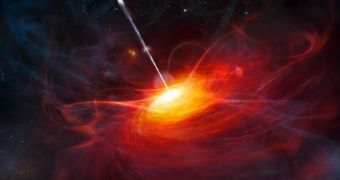Experts announce the discovery of 140 trillion times more water than our entire planet holds, in an enormous cloud surrounding a quasi-stellar radio source (quasar). Astronomers say that this is the largest and oldest water cloud ever discovered in the Universe.
According to early estimates, the cloud is about 12 billion years old, which means that it began forming when the Universe was only about 1.75 billion years old. In other words, the cloud started coming together shortly after the Reionization Epoch concluded.
What this research implies is that water – as a chemical – has been present in the Cosmos since its earliest days, accompanying the development of galaxies, stars, black holes and other cosmic objects.
Interestingly, the water cloud was found surrounding a quasar. These objects are the brightest and most powerful structure in the Universe. They are powered by supermassive black holes, and form active galactic nuclei that can be seen from very far away.
The particular quasar that was studied during this research – called APM 08279+5255 – is powered by a black hole that is about 20 billion times more massive than our Sun. The total power output of this monster rivals that of one quadrillion (one thousand million million) Suns.
“Because the light we are seeing left this quasar more than 12 billion years ago, we are seeing water that was present only some 1.6 billion years after the beginning of the Universe,” says Alberto Bolatto.
“This discovery pushes the detection of water one billion years closer to the Big Bang than any previous find,” adds the expert, a coauthor of the study, and a professor at the University of Maryland.
This investigation is “another demonstration that water is pervasive throughout the universe, even at the very earliest times,” adds Matt Bradford, the lead author of the research. He is based at the NASA Jet Propulsion Laboratory (JPL), in Pasadena, California.
One of the most interesting things about APM 08279+5255 is that it seeds a water cloud that contains 4,000 times more H2O than the entire Milky Way. The reason for that is that our galaxy holds most of its water as ice, rather than as vapor.
Studies of the cloud have revealed that the structure is about 300 trillion times less dense than our planet's atmosphere, and also that it extends for hundreds of light-years around the quasar. The vapors are chilled to around minus 63 degrees Fahrenheit (minus 53 degrees Celsius), Space reports.
Details of the new research will be published in an upcoming issue of the Astrophysical Journal Letters.

 14 DAY TRIAL //
14 DAY TRIAL //